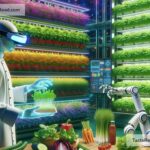The Future of Food and Global Systems: What Lies Ahead?
Food plays a central role in our lives. It is a source of nourishment, joy, and culture. But as the world changes, so does the way we grow, produce, and consume food. With 8 billion people on Earth and the population expected to grow even more, many experts are asking a big question: How can we ensure everyone gets enough to eat while protecting the planet? The future of food is tied to global systems like agriculture, technology, supply chains, and even politics. Let’s explore what lies ahead for food and how we might reshape these systems to meet future challenges.
The Challenges We Face
Before diving into solutions, we need to understand the problems. Today’s food systems are under strain because of several factors:
-
Climate Change: Rising temperatures, droughts, floods, and extreme weather are making it harder to grow crops. Farmers worldwide are struggling to adapt to unpredictable conditions.
-
Population Growth: By 2050, the global population may reach 10 billion. Feeding everyone will require increasing food production by at least 50%. But where will the land, water, and resources come from?
-
Soil Degradation: Over-farming and industrial agriculture have damaged soil in many places, reducing its ability to grow healthy crops.
-
Wasting Food: One-third of all food produced each year is wasted. At the same time, hundreds of millions of people go hungry. This mismatch is a major issue.
-
Global Inequality: Wealthier nations often have plenty of food, while poorer countries struggle with shortages. Climate change only makes these gaps worse.
These challenges show that we need to rethink how food systems work—and quickly.
Innovations in Food Production
The way food is grown may look very different in the future. Scientists, farmers, and innovators are developing new methods to solve food-related problems. Here are some examples:
-
Vertical Farming: Imagine farms stacked inside tall buildings, with crops grown using LED lights and water circulated on shelves. Vertical farming takes up less space and can grow food in urban areas. It also saves water and avoids the use of chemicals.
-
Lab-Grown Meat: It sounds like science fiction, but companies are already making meat without animals. Cells taken from animals are grown in labs to create beef, chicken, or fish. This process uses fewer resources and reduces greenhouse gas emissions.
-
Plant-Based Foods: From pea protein burgers to oat milk, plant-based alternatives are becoming popular. These products provide a sustainable way to eat while reducing reliance on traditional meat and dairy.
-
Aquaculture (Fish Farming): As wild fish populations decline, fish farming is becoming a key solution. By using advanced technologies, aquaculture can provide seafood without damaging ocean ecosystems.
-
Precision Agriculture: Farmers are using drones, sensors, and AI to monitor crops and maximize yields. Precision farming helps reduce waste by focusing resources like water and fertilizer where they’re needed most.
Developing More Sustainable Systems
Beyond how food is grown, we also need to rethink global food systems to make them more sustainable and fair. Governments, businesses, and communities can work together to make positive changes:
-
Local Food Production: Instead of shipping food across continents, many people are turning to local farms. Locally grown food reduces transportation costs and supports small farmers.
-
Reducing Food Waste: Tackling food waste is one of the simplest ways to fix our food systems. Better storage, smarter packaging, and awareness campaigns can prevent food from being thrown away and left to rot.
-
Innovative Supply Chains: The logistics of food distribution need updating. Blockchain technology, for example, could help track food from farm to table, ensuring it stays fresh and safe along the way.
-
Global Cooperation: Food shortages in one country affect everyone. Governments will need to work together to share resources, address hunger, and respond to climate challenges.
-
Education for Farmers: Farmers everywhere should have access to knowledge and tools that help them adapt to modern challenges. Training programs can empower them with techniques to improve sustainability and yields.
The Role of People and Culture
It’s not just governments or companies that shape the future of food—it’s everyday people too. Our eating habits will play a big role in how food systems evolve. For example:
- Eating less meat and more plants can reduce environmental impacts.
- Choosing locally sourced or organic foods supports sustainable practices.
- Advocating for policies that reduce hunger and protect farmland can lead to long-term change.
Cultural shifts also matter. Food is deeply connected to tradition and identity, and changing food systems must respect these values. For example, lab-grown meat might face resistance from people who prefer traditional ways of farming. Finding a balance between innovation and tradition will be key.
A Hopeful Future
Although the challenges ahead are big, the future of food is full of possibilities. By using new technology, reinventing farming practices, and working together globally, we can overcome challenges like hunger and environmental damage. The food systems of tomorrow might look very different, but they could be more efficient, more sustainable, and more inclusive than ever before.
As individuals, we can play our part by making thoughtful food choices every day. Together, consumers, farmers, businesses, and governments can create a world where everyone has access to healthy food—and where the environment thrives alongside us.
The future is in our hands, and the journey starts now.


